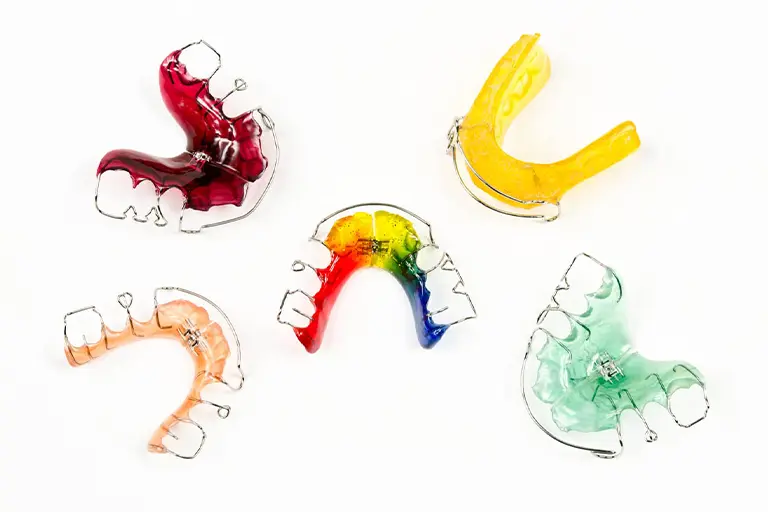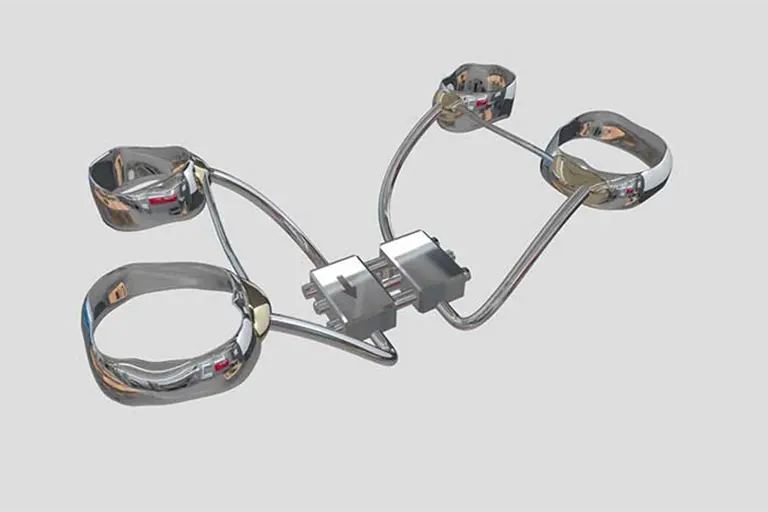A palatal expander is an orthodontic device designed to widen the narrow upper jaw. It helps create space and treat dental problems like overcrowded teeth or bite issues. Palatal expanders are mainly used during the growing stages in children or adolescents to get back to normal jaw occlusion. Two common goals of this appliance as the name suggests are expanding the palate and treating crossbite as a common problem in orthodontics.
Widening the upper jaw
A smaller jaw means a loss of space for permanent teeth to erupt normally. As a result, overcrowded and protruding teeth can occur, which leads to misalignment in teeth. To prevent this problem, we need to expand the palate and make it possible for the dental arch and teeth to fit aligned. Therefore, a palatal expander is used to expand the upper jaw so that space is created for normal teeth growth. Permanent teeth will have more room to grow and crowding is prevented.
Treating crossbite
Crossbite is a malocclusion where upper teeth fit inside or don’t line up on the lower teeth when the mouth is closed. This is because the upper jaw is too narrow to fit on the lower jaw. So, a palatal expander can help widen the upper jaw and fix the crossbite issue. If untreated, these deformities cause the following problems in children:
- Changes in appearance
- Pain in the jaws
- Higher risks of tooth decay
- Difficulty in breathing
- Speech problems
How does a palatal expander work?
Once a palatal expander is secured on the roof of the mouth, it gradually widens the upper jaw on each side. It works by applying gentle and constant pressure to widen the palate over time. The bone regenerates and the soft tissue of the palate solidifies, keeping the desired space stable.
There are both fixed and removable designs that can be used for expansion and space creation. Each expander device is custom-made and unique for each individual’s conditions.

Types of palatal expanders
There are two main types of expander devices in orthodontics: fixed and removable. The fixed appliances are glued into the mouth and bonded permanently, while the removable appliances can be taken out.
Removable expanders
If the roof of the mouth requires slighter expansion or a slower form of treatment, orthodontists may suggest using removable expanders. A removable expander can be removed while eating, exercising, brushing, or for cleaning. So, your child might need extra care and attention on compliance and hygiene.
Removable expanders normally have an acrylic frame component and some type of clasps for retention around the teeth. A screw is designed for adjustments for every reactivation according to the orthodontist’s instructions.
Hyrax rapid palatal expander
Hyrax is a fixed expander attached around the molar teeth. It has metal bands that secure snugly around the molar teeth. There is a screw positioned in the center (under the mouth’s roof). The screw allows the device to be adjusted to the right force.
Quad helix expander
Similar to hyrax, quad Helix is another fixed palatal expander that is banded to molar teeth. It widens toward the roof of the mouth, providing sufficient spacing. Unlike hyrax, it doesn’t need special modifications. It has coils in the arch designed to apply flexible steady force in various ranges.
Haas expander
It is similar to Hyrax in terms of changing the size and opening to achieve the favored palatal space. It also has bands to fit around the molars. However, this type of expander has a palatal acrylic resin pad which can also provide effective expansion forces in the palate.
At what age should my child get an expander?
The lower the age of the patient, the less time is spent on the palatal expander. Since the palate and jaw bones are immature at younger ages, it will be easier to widen the palate. Therefore, children demand less time compared to adolescents and adults.
Once reaching adulthood, surgery may be the only option for widening top jaws. To avoid that, jaw expansion treatment is best done at young ages and it is effective and stable before reaching late puberty. The typical age to get expanders can be between ages 8-12. Depending on the cases, an orthodontist may start from a younger age when the child might get faster results.
How long does palatal expansion take?
Typically, a palatal expander should be in the child’s mouth for at least 6 months or in some cases for 1 year. Children should keep up with the time the orthodontist recommends to achieve the best expansion results until the palate solidifies. For smaller children, the expander can be installed for 2 to 3 months. During this time, the bones of the palatal area widen, and for the fusion of the bones, 4 to 6 months is needed to have the expanders on.
How much does a palatal expander cost?
The cost of a palatal expander can vary from one person to another. Factors like the length of treatment, patient’s age, complexity of the case, and the type of palate device influence the price.
Palatal expansion for children can cost between $1,000 and $2,500 if your kid is in the phase-one interceptive treatment. This is also known as early treatment which typically starts between 6 and 9. Orthodontists recommend it as the best time to correct faster and more easily the growth of the jaw and bite problems like underbite.
However, the cost of adult or children palatal expansion that includes more comprehensive treatment can range from $3,500 to $6,000. Those are average prices that can differ depending on the individuals and necessary accompanying devices like braces types.
How to clean palatal expanders?
Once the expander is fixed, regular cleaning of both teeth and expanders is necessary. Otherwise, the accumulation of bacteria on teeth and expanders causes tooth decay and inflamed gums. Removable expanders can be taken out to clean thoroughly. Children can brush their teeth twice a day like usual and clean the device easier before putting it back in their mouth.
For fixed expanders, remaining food particles between the teeth and on the gums make the cleaning process difficult. Here are some tips:
- Brush teeth carefully with fluoride toothpaste.
- Try to use an electric toothbrush rather than a manual brush.
- Use anti-bacterial mouthwash and dental floss for cleaning the teeth.
- Your child must avoid hard, sticky foods (for example, candy, chewing gum, apples, etc).
- Avoid chewing on other hard things like ice or pencil to prevent any damage.

What are the risks and complications of a palatal expander?
After using expanders for a short period of time, you may notice a gap between the central incisors in the upper jaw (maxilla). Naturally, this was predictable and can be treated. In most cases, this gap will restore over time, but sometimes orthodontic treatment should be carried out.
Other slight side effects are:
- Mild pain and discomfort in the first days
- Lisping (it is temporary as the device makes pronouncing some words difficult)
- Increase of saliva
- Slight headaches
Are there alternatives if you don’t want to use palatal expanders?
There are some other ways to help treat issues caused by a narrow upper jaw or even widen the palate like surgery. In the following passages, we will discuss 3 important treatment types.
- Orthodontic braces: Braces are versatile orthodontic tools used in various treatments. This can include treating crossbites and overcrowded teeth in children and adults.
- Orthognathic (jaw) surgery: Jaw surgery can be used to widen the upper jaw if expanders can’t be used. For more bone restoration in the palatal area, there should be small gaps between the palates. With the regeneration of the bone tissue, the cleft parts of the bones are fused together. Jaw surgery is operated on individuals whose bone growth has been completed and not children. For example, adults rather than using palatal expanders may need jaw surgery operations to successfully achieve the expansion of their palates.
- Pulling a tooth: Sometimes, to prevent crowded teeth, extracting one or more teeth should be performed. Overcrowded teeth can lead to impacted teeth and troubles in the eruption of the teeth. Extraction is one type of method for the reduction of orthodontic treatment time.
